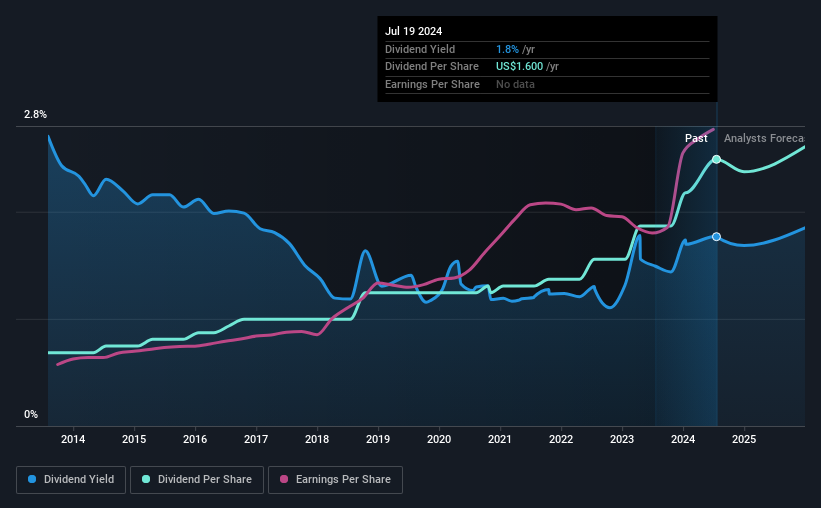- United States
- /
- Banks
- /
- NasdaqCM:BFC
Bank First (NASDAQ:BFC) Will Pay A Larger Dividend Than Last Year At $0.40
Bank First Corporation (NASDAQ:BFC) has announced that it will be increasing its periodic dividend on the 9th of October to $0.40, which will be 33% higher than last year's comparable payment amount of $0.30. Although the dividend is now higher, the yield is only 1.8%, which is below the industry average.
See our latest analysis for Bank First
Bank First's Payment Expected To Have Solid Earnings Coverage
The dividend yield is a little bit low, but sustainability of the payments is also an important part of evaluating an income stock.
Bank First has established itself as a dividend paying company with over 10 years history of distributing earnings to shareholders. While past records don't necessarily translate into future results, the company's payout ratio of 16% also shows that Bank First is able to comfortably pay dividends.
EPS is set to fall by 13.4% over the next 12 months. But if the dividend continues along the path it has been on recently, we estimate the future payout ratio could be 22%, which would be comfortable for the company to continue in the future.

Bank First Has A Solid Track Record
The company has an extended history of paying stable dividends. The dividend has gone from an annual total of $0.44 in 2014 to the most recent total annual payment of $1.60. This implies that the company grew its distributions at a yearly rate of about 14% over that duration. It is good to see that there has been strong dividend growth, and that there haven't been any cuts for a long time.
The Dividend Looks Likely To Grow
Investors could be attracted to the stock based on the quality of its payment history. We are encouraged to see that Bank First has grown earnings per share at 17% per year over the past five years. A low payout ratio and decent growth suggests that the company is reinvesting well, and it also has plenty of room to increase the dividend over time.
Bank First Looks Like A Great Dividend Stock
Overall, we think this could be an attractive income stock, and it is only getting better by paying a higher dividend this year. The company is generating plenty of cash, and the earnings also quite easily cover the distributions. If earnings do fall over the next 12 months, the dividend could be buffeted a little bit, but we don't think it should cause too much of a problem in the long term. Taking this all into consideration, this looks like it could be a good dividend opportunity.
Companies possessing a stable dividend policy will likely enjoy greater investor interest than those suffering from a more inconsistent approach. Still, investors need to consider a host of other factors, apart from dividend payments, when analysing a company. For example, we've picked out 1 warning sign for Bank First that investors should know about before committing capital to this stock. Is Bank First not quite the opportunity you were looking for? Why not check out our selection of top dividend stocks.
Valuation is complex, but we're here to simplify it.
Discover if Bank First might be undervalued or overvalued with our detailed analysis, featuring fair value estimates, potential risks, dividends, insider trades, and its financial condition.
Access Free AnalysisHave feedback on this article? Concerned about the content? Get in touch with us directly. Alternatively, email editorial-team (at) simplywallst.com.
This article by Simply Wall St is general in nature. We provide commentary based on historical data and analyst forecasts only using an unbiased methodology and our articles are not intended to be financial advice. It does not constitute a recommendation to buy or sell any stock, and does not take account of your objectives, or your financial situation. We aim to bring you long-term focused analysis driven by fundamental data. Note that our analysis may not factor in the latest price-sensitive company announcements or qualitative material. Simply Wall St has no position in any stocks mentioned.
Have feedback on this article? Concerned about the content? Get in touch with us directly. Alternatively, email editorial-team@simplywallst.com
About NasdaqCM:BFC
Flawless balance sheet with high growth potential and pays a dividend.
Market Insights
Community Narratives



